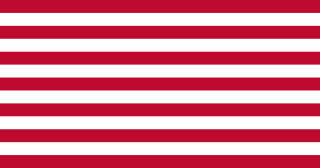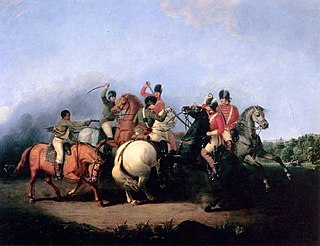 |
| Armed Forces |
| United States |
|---|
| Great Britain |
| France |
| Related topics |
During the American Revolutionary War, the Georgia State Navy consisted of only a few ships, most of which were destroyed in 1778 and 1779.
 |
| Armed Forces |
| United States |
|---|
| Great Britain |
| France |
| Related topics |
During the American Revolutionary War, the Georgia State Navy consisted of only a few ships, most of which were destroyed in 1778 and 1779.

Georgia was one of the first of the Thirteen Colonies to engage a ship for its own naval purposes. In June 1775, not long after the American Revolutionary War broke out, it commissioned an armed sloop for the purpose of seizing a British transport carrying munitions that was destined for the Georgia port of Savannah. [1] Funds were authorized in 1776 for expeditions by Captains Oliver Bowen and Job Pray to acquire and arm ships in the West Indies; whether these were actually successful is unknown. In November 1776 the state established an admiralty court for adjudicating the distribution of prizes captured at sea.
The state also authorized the construction of row galleys in 1776. A total of four were put into service: Washington, Lee, Bulloch, and Congress. The galleys' crews came from slaves seized when the Patriots confiscated Royalist Governor James Wright's estate. [2] In addition, troops from the Georgia State Militia went on board the galleys to serve as marines. [3]
The galleys were unsuited for use on the high seas, but with their shallow drafts and oars were well-suited to serve along the state's coast and on its rivers. They carried troops and supplies for the two unsuccessful invasions of East Florida in 1777 and 1778. During these operations the galleys also secured river crossings, escorted vessels transporting troops, and protected the army's flank. [4]
The galleys' greatest success was the Frederica naval action on 19 April 1778. Washington, Lee, Bulloch, and some boats captured the 12-gun sloop HMS Hinchinbrook and the Loyalist privateer Rebeccas off St. Simons Island, [5] after the British vessels had grounded and their crews had escaped ashore. [4] The Georgia State galleys took their prizes to Sunbury. [6]
The four galleys served during the 1779 Siege of Savannah, a failed Franco-American attempt to retake the city from the British. The continued British occupation of the state (the only state in which the royal governor returned to take control), made the construction of further ships impossible. [7]
In the late 20th century, it became a popular practice for the Governor of Georgia to award a certificate to new members of the Georgia General Assembly (and others) bestowing upon them the honorary title of Admiral of the Georgia Navy. [8]
| Name | Launch year | Armament | Captain | Fate |
|---|---|---|---|---|
| Washington | mid-1777 | 2 × 18-pounder + 2 × 12-pounder + 2 × 9-pounder + 6 × 6-pounder guns | John Hardy | Stranded and burned at Ossabaw Island by her crew in January 1779 after the fall of Sunbury, GA. |
| Bulloch | 1778 | n.a. | Archibald Hatcher | Stranded and burned at Ossabaw Island by her crew in January 1779 after the fall of Sunbury, GA. |
| Lee | mid-1777 | 1 × 18-pounder + 1 × 12-pounder + 2 × 9-pounder + 2 × 6-pounder guns | John Braddock | HM galley Comet captured Lee in March 1779; the British Royal Navy took her into service as HM galley Vindictive |
| Congress | mid-1777 | 1 × 12-pounder + 1 × 9-pounder + 2 × 4-pounder guns + 2 × 1-pounder swivel guns | John Newdigate | HM galley Comet captured Congress in March 1779; the Royal Navy took her into service as HM galley Scourge |

The Continental Navy was the navy of the United States during the American Revolutionary War and was founded October 13, 1775. The fleet cumulatively became relatively substantial through the efforts of the Continental Navy's patron John Adams and vigorous Congressional support in the face of stiff opposition, when considering the limitations imposed upon the Patriot supply pool. The main goal of the navy was to intercept shipments of British matériel and generally disrupt British maritime commercial operations. The initial fleet consisted of converted merchantmen because of the lack of funding, manpower, and resources, with exclusively designed warships being built later in the conflict. The vessels that successfully made it to sea met with success only rarely, and the effort contributed little to the overall outcome of the war. The fleet did serve to highlight a few examples of Continental resolve, notably launching Captain John Barry into the limelight. It provided needed experience for a generation of officers who went on to command conflicts which involved the early American navy. After the war, the Continental Navy was dissolved. With the federal government in need of all available capital, the few remaining ships were sold, the final vessel Alliance being auctioned off in 1785 to a private bidder.
The Royal Navy has used the name Comet no fewer than 18 times:

The Battle of the Rice Boats, also called the Battle of Yamacraw Bluff, was a land and naval battle of the American Revolutionary War that took place in and around the Savannah River on the border between the Province of Georgia and the Province of South Carolina on March 2 and 3, 1776. The battle pitted the Patriot militia from Georgia and South Carolina against a small fleet of the Royal Navy.

The siege of Savannah or the Second Battle of Savannah was an encounter of the American Revolutionary War (1775–1783) in 1779. The year before, the city of Savannah, Georgia, had been captured by a British expeditionary corps under Lieutenant-Colonel Archibald Campbell. The siege itself consisted of a joint Franco-American attempt to retake Savannah, from September 16 to October 18, 1779. On October 9 a major assault against the British siege works failed. During the attack, Polish nobleman Count Casimir Pulaski, leading the combined cavalry forces on the American side, was mortally wounded. With the failure of the joint attack, the siege was abandoned, and the British remained in control of Savannah until July 1782, near the end of the war.

A South Carolina Navy has been formed twice by the State of South Carolina. The first time was during the American Revolutionary War, in which the state purchased and outfitted armed vessels independent of the Continental Navy. The second time was during the American Civil War, when its navy was also distinct from the Confederate States Navy.

The Pennsylvania Navy served as the naval force of Pennsylvania during the American Revolution and afterward, until the formation of the United States Navy. The navy's vessels served almost exclusively on the Delaware River, and were active in first defending the approaches to the city of Philadelphia during the British campaign that successfully occupied the city in 1777, and then preventing the Royal Navy from resupplying the occupying army.

Samuel Elbert was an American merchant, soldier, and politician from Savannah, Georgia.

The southern theater of the American Revolutionary War was the central theater of military operations in the second half of the American Revolutionary War, 1778–1781. It encompassed engagements primarily in Virginia, Georgia and South Carolina. Tactics consisted of both strategic battles and guerrilla warfare.

The Frederica naval action was a naval battle during the American Revolutionary War in which three galleys of the Georgia State Navy defeated a British raiding party off the coast of Georgia. The action occurred on April 19, 1778.

The Massachusetts Naval Militia, was a naval militia active during the American Revolutionary War. It was founded December 29, 1775, to defend the interests of Massachusetts during the war.
USS Spitfire was a row galley authorized and constructed by Rhode Island during the American Revolution, and was placed in service in 1776 in the Rhode Island Navy. During this age of sail, row galleys were highly maneuverable compared to sailing ships whose movements were dependent on the wind. Spitfire had a reportedly successful career, helping to capture British cargo ships and engaging in the fight against British warships.

The historical battles of Lexington and Concord in Massachusetts sparked the beginning of the American War for Independence on 19 April 1775; soon after, the rest of the thirteen American colonies were pulled into the conflict. Many of the leaders in the rebellion recognized that a naval engagement against the British was the primary option to prevent the British from restoring Crown rule by military occupation.

The Connecticut State Navy was the colonial navy of Connecticut during the American Revolutionary War. Established in 1775, all of its ships were destroyed or captured by 1779. In the remaining years of the war a few smaller ships were commissioned to interdict smuggling between the Connecticut shore and Tory-controlled Long Island.

The Rhode Island State Navy was the first colonial or state navy established after the American Revolutionary War began in April 1775 with the Battles of Lexington and Concord. On the following June 15, the General Assembly authorized the acquisition of two ships for the purpose of defending the colony's trade. The state's ships were generally used for defensive operations within Narragansett Bay, although some prizes were taken. The state was also one of the first to authorize privateering.
The Province of Georgia was a significant battleground in the American Revolution. Its population was at first divided about exactly how to respond to revolutionary activities and heightened tensions in other provinces. When violence broke out in 1775, radical Patriots took control of the provincial government, and drove many Loyalists out of the province. Georgia also served as the staging ground for several important raids into British-controlled Florida.

The North Carolina State Navy during the American Revolutionary War consisted of a relatively modest number of ships, and was active from 1776 to 1779. The state and the Continental Congress were concerned about the defense of Pamlico Sound, and the key Ocracoke Inlet, through which a large number of inbound merchant ships traveled, bringing war-related supplies from Europe and the West Indies.

HMS Kingfisher was the second ship in the 14-gun Swan class of ship sloops, to which design 25 vessels were built in the 1760s and 1770s. She was launched on 13 July 1770 at Chatham Dockyard, and completed there on 21 November 1770. She took part in the American Revolutionary War, enforcing the blockade of the Delaware Bay, and served in the Battle of Turtle Gut Inlet, near Cape May, New Jersey. While under the temporary command of Lieutenant Hugh Christian, she was burnt by her own crew to avoid capture on 7 August 1778 in Narragansett Bay during the Battle of Rhode Island.
HMS Viper was a 6-gun galley, the former South Carolina Navy's Rutledge, which the British captured on 4 November 1779 at Tybee. She was broken up in 1785.
HM galley Comet was the South Carolina Navy's brigantine Comet, which the government of South Carolina purchased in 1775. The British Royal Navy captured her in 1777. She grounded and was destroyed in 1780.
HMS Greenwich was the American privateer Greenwich that HMS Maidstone captured on 20 April 1778. She served for a little more than a year, particularly at Georgia, before she was burnt in May 1779.